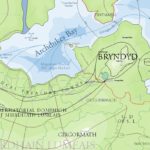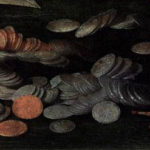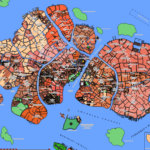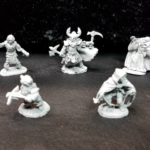There’s a sense of scale that I wish to convey. Place and time reach over great extents that compare to the real world which is the ostensible source of all inspiration for the fictional world of Asdar. The size of the globe of Asdar is nearly the same as the Earth. My emphasis of development is on the western portion of the old world which is basically one huge mass of continents glued together, plus outlying Orrhymby.
My frame of reference for history is since the decline and end of the Ice Ages on Earth. On Earth that meant a series of coastal inundations. Like Earth, Asdar is now also in an interglacial period. On Asdar, there were two major floods with global impact on all coastal areas, the Great Flood (Flood of Aturyanda) and the Flood of Karuthaya. Both have Kalaman names. In the west, Kalaman civilization is one of the prestigious ancient cultures with a very long tradition about the past.
I focus on the nations of the Pallathantic Region within the past five centuries and especially the past two. It’s analogous with focusing on western European history in modern times. Thus you may suppose that the world of Asdar is rather derivative. Very broadly, it is derivative. For the Earth, we experience a definite, but progressing ‘now.’ The word ‘now’ for a fictitious world can be troubling for Asdar’s timeline which does not have a direct correspondence with Earth’s timeline.
There’s an implied spectrum in conworlding that answers to the question: How much like Earth is your world? Is your story simply set in modern-day Earth? Is it alternate Earth? Is it a world with earthlike qualities but a different topology and progression? Is the focus culture human or a different species? Is your scope a language, a country, a region, a world, a cosmos? The spectrum has most Earthlike on one very definable end and most unearthlike on the other, rather undefinable end. Both ends have merit. Earthlike qualities provide a stable frame of reference for the visitor to your creation. Familiarity helps ensure understanding and can be comforting and accessible. It can also be very boring. The other end isn’t really an end at all, but a frontier, and that’s how unearthlike the conworld can be. This is the place where bizarre aliens, strange landscapes, and unimaginable cultural practices take form. It’s a frontier because there’s no point at which you can say you’ve reached the end. The unearthlike inspires and intrigues the imagination. It can also be horribly inaccessible. A story about a race of eight-limbed fungi creatures would possibly challenge even H. P. Lovecraft and at least he would include humans in it. Without humans, such a story would make a great exercise, but probably not satisfy many readers. I’ve found my own middle path, probably more on the Earthlike end of the spectrum. Humans using magic and humans interacting with humanlike entities ensures that the world is accessible to humans but makes for situations and outcomes inconceivable in the conventional world.
My preference is for inclusion. Asdar is really just Earth pressed through the sieve of my imagination. This taps into my own subconscious thoughts about the world and I expect it does for the reader. The landmass of the old world is not immediately recognizable as Eurafrasia, but that’s what inspires it. There are East Asian-looking people in the far east, Dravidian-looking people in the south, African-looking people in the far south, and European-looking people in the west. It’s Eurocentric, I suppose, in the same way that you would judge Middle Earth or Westeros (Game of Thrones) to be so. I find my cultural identity in the European past rather than in the brief span of European occupation of North America. I’m one of those Americans who finds the rich architectural and cultural wealth of Europe irresistible. I can say the same to a lesser extent for the marvelous civilizations of north Africa, India, and China. A world without different ethnic humans and exotic locales is inconceivable to me. A world with only European-looking people would be very different than a world with all the ethnic groups we see today. The principle of duality requires both tolerance and racism in such a world.
Of course, Asdar is a fantasy setting and I have included inspirations from original Dungeons and Dragons which borrowed freely from Tolkien, Moorcock, H.P. Lovecraft, and others. There are elves, dwarves, halflings, orcs, giants, goblins, trolls, and countless other “races.” These creatures, brought to the forefront by Tolkien, were in turn taken from European myth and legend. Scientific moderns see these humanlike creatures as nothing more than the fables of over-active primitive minds. I see them as oral artifacts about the distant past when barely modern humans shared this world with other humanlike creatures, such as Neanderthal. How close the Scandinavian tales of trolls compare to modern Bigfoot sightings we may never completely know.
Great floods and giants are more than just bible stories and they have global currency. They are accounts of ancient experience during a time before Archimedes said “Give me where to stand and I shall move the world.” A nine-foot tall giant human is no less plausible than a twenty foot, three ton ground sloth (Eremotherium). In fact, giant humans may have been the norm for a long, long time before our brief historic present. Schliemann proved that the ancient myths of Homer corresponded to a tangible geography. The discovery of Göbekli Tepe compels us to contemplate a human past twice as long as historians teach us. The questioning of the historic past is still in full swing and, in time, a new generation of academics will accept that Atlantis is a corrupted memory of a prehistoric advanced civilization. The institutions of science and religion are too specialized and ideologically self-serving to accept the details of human past at present.







